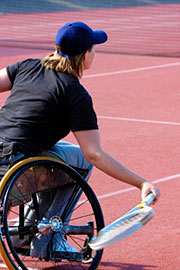
 Participation in recreational and social activities is essential for people with disabilities, and participation is easily achieved by planning for needed adaptations.
Participation in recreational and social activities is essential for people with disabilities, and participation is easily achieved by planning for needed adaptations.
- Most community events, meetings, and recreational activities can be held at disability accessible sites.
- Sports and recreational activities can be adapted for people with disabilities.
Regular physical activity provides more energy and endurance for everyday activities, improves muscle tone, and assists in healthy weight maintenance. Fitness facilities can be safe places to be physically active and social. Some gyms and health clubs in Virginia are more accessible to people with disabilities than others. Visit the facility and thoroughly check it out to make certain it meets your needs, before you make any commitments.
Sheltering Arms Physical Rehabilitation Centers, in the Greater Richmond area, provides exercise equipment specifically designed for people with disabilities. Their "Club Rec" program supports people with disabilities to use exercise equipment and the therapeutic pool. Additionally, they offer social, recreational and wellness programs. Many YMCA's have accessible facilities and offer a variety of exercise classes that can be adapted for someone with a disability. Contact your local YMCA for more information.
There are some significant barriers that people may have to overcome to participate in recreational and social activities, even if they are accessible. Barriers that may limit participation in physical activity include:
- Reliable transportation, private or public – often transportation services and city buses don't operate in the evenings
- Lack of information about accessible events
- Lack of safe environments to be physically active, especially in rural areas
- Lack of understanding that any physical activity is better than no activity
 Many of us think about physical activity as high impact or high energy, such as aerobics, biking, or running. Any physical activity a person does during the day can promote endurance, flexibility, and muscle tone. Daily physical activities may include house cleaning, gardening, walking the dog, or grocery shopping. Most stretching and low impact exercises, such as yoga and water aerobics, can be easily adapted for people with disabilities. There are also many popular sports that are now adapted for people with disabilities, including golf, basketball, rugby, volleyball, and river rafting. Diabetes Self-Management Magazine published an article (in PDF format), "Wheelchair Exercises for Fitness and Confidence, " that is not only good for someone that uses a wheelchair, but anyone with limited mobility.
Many of us think about physical activity as high impact or high energy, such as aerobics, biking, or running. Any physical activity a person does during the day can promote endurance, flexibility, and muscle tone. Daily physical activities may include house cleaning, gardening, walking the dog, or grocery shopping. Most stretching and low impact exercises, such as yoga and water aerobics, can be easily adapted for people with disabilities. There are also many popular sports that are now adapted for people with disabilities, including golf, basketball, rugby, volleyball, and river rafting. Diabetes Self-Management Magazine published an article (in PDF format), "Wheelchair Exercises for Fitness and Confidence, " that is not only good for someone that uses a wheelchair, but anyone with limited mobility.
There are many way to find out what activities and events are going on in your area. Often local television, radio stations and newspapers announce community events, but you may also try some local organizations such as centers for independent living, nonprofit organizations, and local departments of parks and recreation. The organization, PosAbilities Unlimited, has also published a guide, ", " that may be helpful to explore various recreation options.
People with disabilities may find it more challenging to be physically active if they have to rely on another person to be active. Below is a chart that indicates the rates of physical activity for people with disabilities and for those without.









